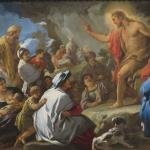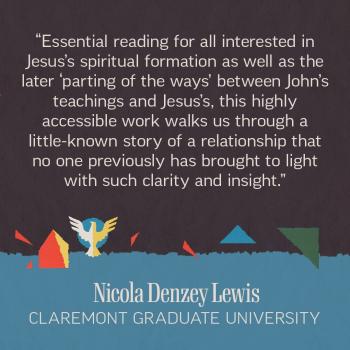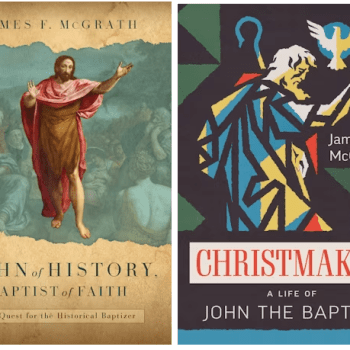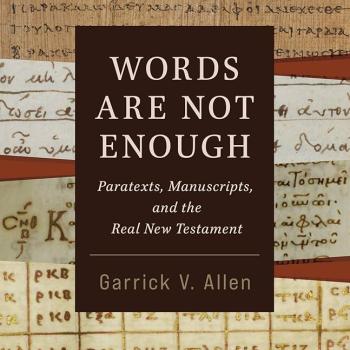All readers of biblioblogs presumably know Steve Wiggins’ name, and those who publish academic books may know him as editor for Oxford University Press. As a religion scholar and author of academic books and articles, Steve’s interest in recent years has focused on the genre of horror, leading to the publication of his two most recent books, Holy Horror and Nightmares with the Bible. I am delighted to be able to draw these books to your attention and to share with you an interview Steve graciously took the time to give me so that I could help spread the word about these important books that can be helpful both for understanding popular culture and for understanding the Bible. My questions are in bold.
___
1) You started out in Biblical and Ancient Near Eastern studies, writing books and articles on gods and goddesses and then on weather as it was viewed by biblical authors. I will ask you a question that I sometimes get asked: is your more recent focus on horror a natural outgrowth of your earlier work, or simply a separate interest? Does the modern genre of horror draw on and/or help us understand literature from the Ancient Near East that is older than the Bible?
Like many scholars who work in horror studies, my interest was latent all along. To get at your question I have to reflect on my employment history a little: I held a full-time professorship until 2005. My research, supported by an academic library, was in my doctoral field of Ancient Near Eastern studies (Ugaritic mythology, primarily), and then a side project on weather terminology. When that position unexpectedly ended not only did I have to change careers—because of market conditions—I also no longer had library access. I still don’t.
I’ve always been a writer. During those long years between jobs I focused on fiction and on my blog (Sects and Violence in the Ancient World). Eventually I had a long commute to work in New York City, and I easily read over a hundred books a year on the bus. When it dawned on me that most of these books were on monsters, I recalled the book Sacred Terror by Douglas Cowan. I read this when it first came out in 2006. Newly unacademic, I was astonished that a respected religion scholar could write on horror.
I’d stopped watching horror films after seminary. When I lost my long-term academic post I began watching them again. It was a kind of therapy. Finally it occurred to me: reading all these books on horror themes was research, but of an unconventional kind. Publishers tend not to encourage editors to write, but I’d been blogging and getting fiction published anyway, so I tried to see if I could get material together on the Bible and horror. Holy Horror and Nightmares with the Bible were the results.
In that sense, yes, the horror interest is an outgrowth of my earlier work. It is certainly informed by it. Horror has deep roots in biblical and other ancient literature. In Nightmares with the Bible, I begin by tracing demons from ancient Mesopotamia through the biblical world. Often books that do this kind of thing suffer from not having any real expertise in Ancient Near Eastern studies. My weaknesses are more in the realm of my newness to reception history, which is what both books represent.
2) What led you to write not one but two books about horror? How are your two books different from one another? Horror has never been my favorite genre. What should fans expect from your books, and why should those who may not be fans read them nevertheless?
Interestingly enough, the horror community is more receptive to my work than the academy ever was. Since writing on horror I have come to know scholars from many disciplines who’ve welcomed me to the guild. I always had to struggle for acceptance among biblical scholars. That’s worth thinking about.
Why two books? The short answer is I had enough material. The longer response is that Holy Horror is specifically about the reception history of the Bible itself. How does the Bible appear in horror films? While writing it I realized that horror, which thrives on sequels, would easily expand way beyond the confines of an accessibly written, non-technical book on the subject. I didn’t include any sequels and the focus was on the Bible.
At any given time I have five or six book projects going. After McFarland accepted Holy Horror for publication—just after, in fact—Fortress Academic/Lexington announced their new series Horror and Scripture. I knew one of the series editors, who asked if my book was available. Since it was under contract already I sent a proposal for a book that combined two of my then current projects: a layperson’s history of demons and a book that looked at the sequels to the movies explored in Holy Horror. Instead of looking at reception history of the Bible in the sequels, Nightmares with the Bible looks at how demons develop through various horror franchises.
Horror often gets a bad rap among those who study popular culture, especially religion in popular culture. Horror, however, is often based on and covers much of the same conceptual territory as religion. Understanding religion requires understanding fear. One of the main theses of Holy Horror is that laypeople in general understand the Bible from the way it’s presented in popular culture. They don’t read academic books on the Bible. Increasingly they don’t attend religious services. Movies, and pop culture use the Bible all the time and there are a lot more people who watch movies than who read academic books on the Bible.
I wrote both of my books so that readers need neither be fans of horror nor to have watched the movies I discuss. I give sufficient description—avoiding gore, since I’m squeamish—that the themes of the movies are clear. I find that when I read books on horror the result is I end up having a list of movies I want to watch afterwards. Horror is a highly misunderstood, often surprisingly sophisticated, genre. Many horror auteurs are exploring how religion and fear work together. Their films are even starting to win major awards. I say to people who don’t like horror, “Have you tried any lately?” It’s often less disturbing than the news headlines.
3) In writing recently on women in the Gospels, many of them are said to have been liberated from demons through their contact with Jesus. For many people today, demon possession is associated with what one sees in movies like The Exorcist, and/or with what we think of as mental/psychiatric ailments. Yet in the Gospels and other ancient sources things like being unable to stand straight and other ailments we think of as physical and not mental are attributed to demons. Is the appearance of demons in modern horror literature, television, and cinema helpful to modern people seeking to understand ancient texts, or does it give them misconceptions about what ancient people thought–or perhaps a bit of both?
Demons are explanatory devices. That hasn’t changed since antiquity. I address this in Nightmares to some extent. In the ancient world nobody doubted demons existed. I’ve read compelling analyses that they weren’t seriously doubted right up until the nineteenth century. The real problem is nobody knew what they were in antiquity. One of the things I learned in researching Nightmares is that many different kinds of beings were labeled “demons.” The fallen angel narrative (which I grew up with) was only one of several.
Demons today are clearly understood through the lens of The Exorcist. It’s difficult to imagine a movie today that could rival its impact on understanding a “religious” phenomenon. Exorcism exists in a continuous line from ancient Mesopotamia to modern-day New York City. As skepticism grew in the post-Enlightenment period, exorcisms became fewer and fewer and more and more obscure (in western culture). The Exorcist almost single-handedly revived interest in the Roman Rite and defined what demons could become. Requests for exorcisms have been on the rise ever since.
Would Jesus have understood Regan MacNeil as “possessed”? The key signs of demonic possession in The Exorcist all developed in the Middle Ages. Levitation, speaking in unknown languages, and sexual profanation of religious symbols aren’t part of biblical possession. Pop culture defines demons, even as it defines understanding of the Bible.
Demons were one explanation for illness and misfortune in antiquity, but they weren’t the only one. The Bible seems to indicate that mental illness was something that didn’t necessarily imply demons. We tend to think of people in antiquity as benighted, but they were also capable of “advanced” thinking. The beginnings of science lie in antiquity. What changed over time was the worldview. Their worldview pretty much necessarily contained what we might call a spiritual dimension. Since “spiritual” phenomena can’t be lab tested, modern empirical science has dismissed them. Demons like to lurk in the cracks, however. This gap between science and what we still feel as spirituality allows for many hiding places for demons even in the modern world.
In short, to answer your question, it’s a bit of both.
4) What’s next for you as pertains to horror (or are you moving on to a different focus in your next major project)?
This is always a difficult question to answer. Since I’m not part of the academy there’s no professional compunction to publish. I have written seven novels (none published) and countless fictional short stories. This is a market I’d like to break into. Every time, just as I’m starting getting into it, however, something draws me back to nonfiction.
I currently have four nonfiction books underway, all related to monsters in some way, and all far enough along that they could become book-length. Since I’m trying to supplement an editor’s salary with royalties, there are compelling reasons to continue in the vein where I’ve had two books recently published. I hesitate to reveal what exactly these projects are since academics, who have schedules that allow for research and writing (nine-to-five jobs go all year long, regardless of semester breaks, with limited numbers of vacation days), could easily swoop in and write treatments of subjects I’ve noticed from my idiosyncratic viewpoint. My employment puts me at a disadvantage here.
I can say that my future writing will not be submitted to academic presses. This won’t be because they’ll be any less “academic” in rigor, but because academic pricing will always limit the number of people who’ll be able to afford them. For instance, I was invited to do a weekend program at a church in Manhattan around my book Weathering the Psalms. It was fairly well attended, but the pastor told me that congregants couldn’t spend $22 on a single book. Academic publishers routinely underestimate the appeal that interesting books might have for those of us outside the academy. I still think $20 is a lot for a book. How can our society educate itself when we ask people to spend so much on books when other, cheaper diversions compete? I’m hoping to find more of a trade readership since both Holy Horror and Nightmares with the Bible were written so that non-academics could easily (and enjoyably, I hope!) read them.
I’m grateful to Steve for the chance to interview him. Read his books (if you cannot afford them, ask your library to get them) and also read his blog!
















